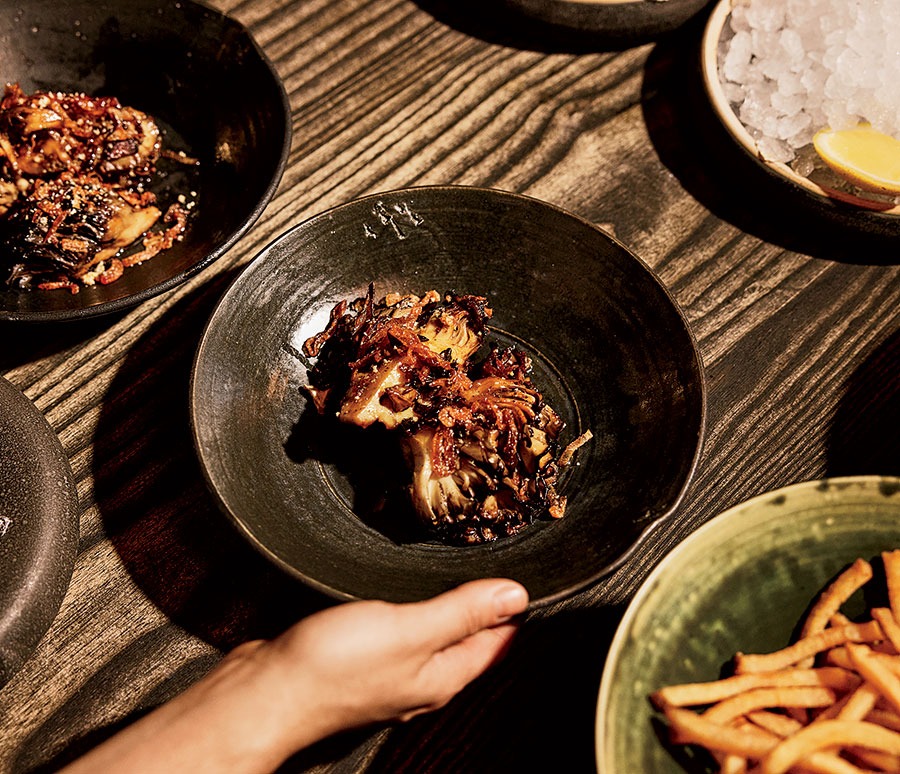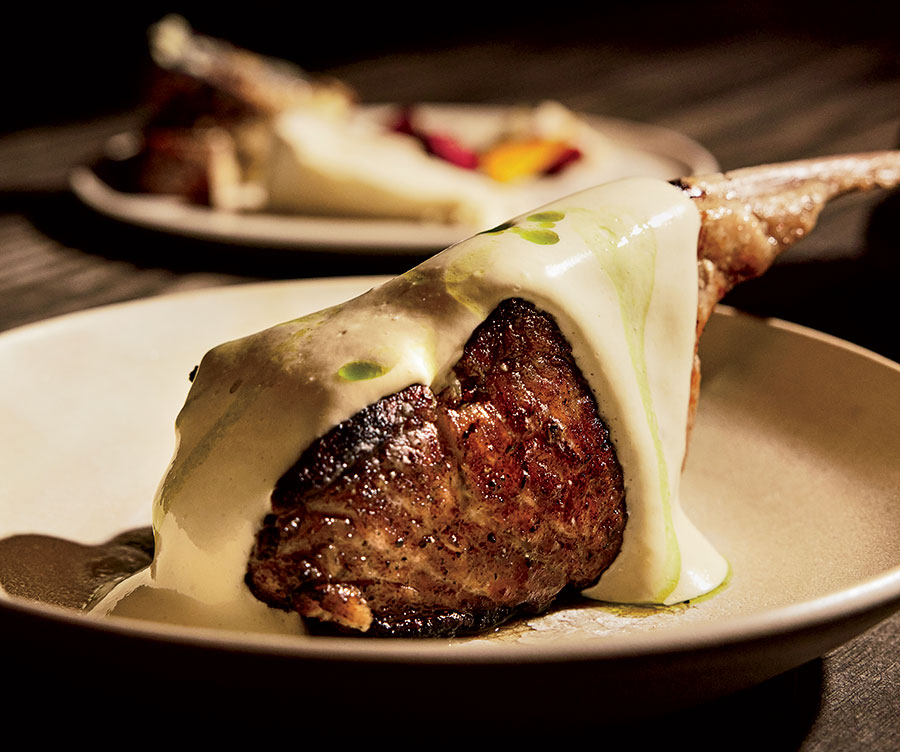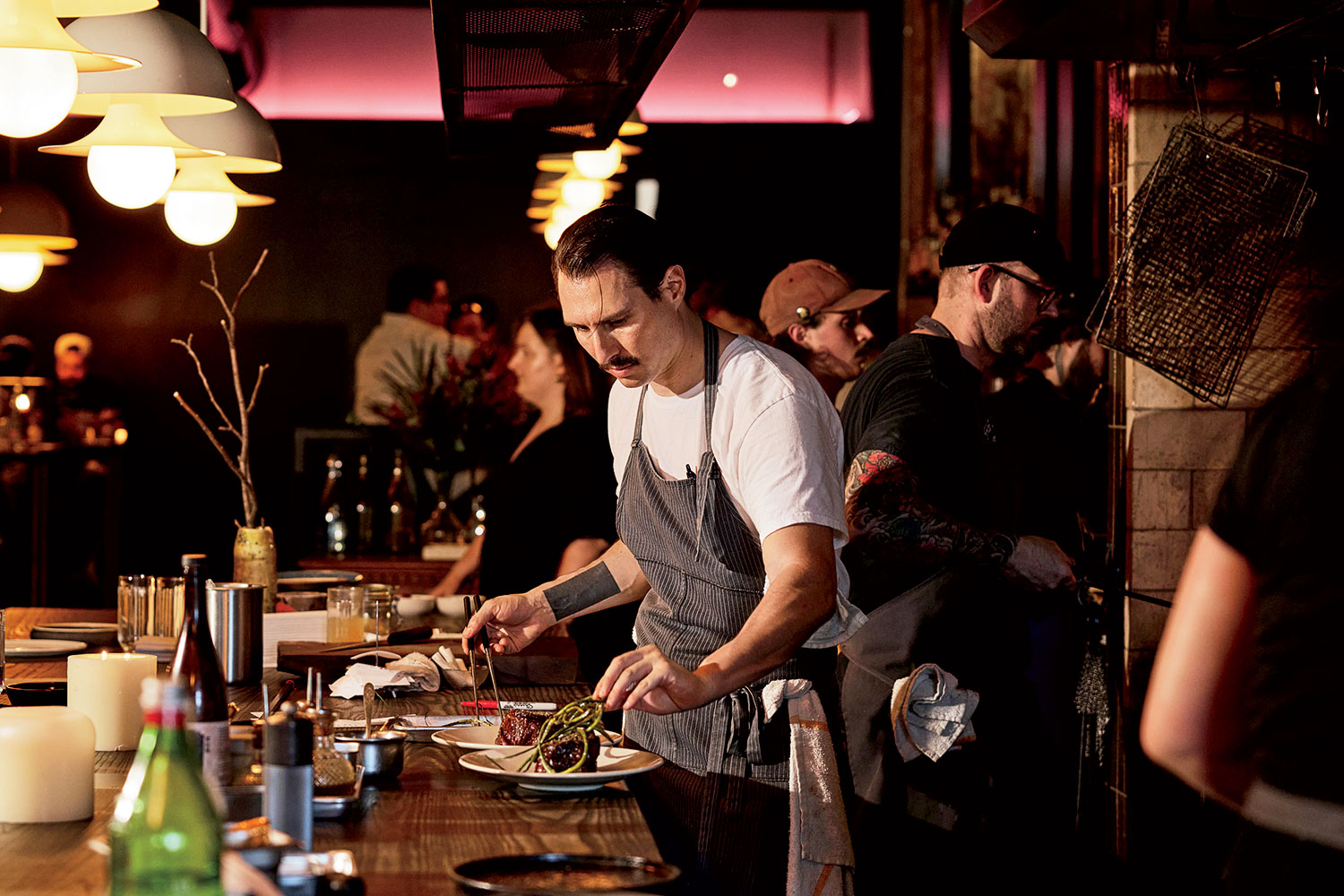My wife and I couldn’t find out anything about the new place except that it was open on a Monday, and we were hungry. I was familiar with it only from a few dramatically lit shots on social media that had that whole “if Caravaggio were on Instagram” aesthetic. I couldn’t tell if its name, Warlord, was ironic or in earnest, or if it signaled the presence of gaming nerds or gun enthusiasts. I couldn’t even find a menu. But the Avondale restaurant, which had opened less than a month earlier, in April, seemed intriguing.
We lucked into a corner table in the no-reservations dining room, adjusted to the soft-glow lighting and soundtrack of old rock standards, and ordered a meal of shared plates with zero spiel from our server. They were simple and deftly seasoned dishes that pulled us in and made us pay attention. It was “Oh wow, try this” over and over. There was a bowl of raw and pan-wilted arrowhead spinach that was mineral and buttery, with a tense shot of vinegar. There was a chunk of grilled pork shoulder that had spent a month in the dry-aging fridge (a focal point of the dining room), leaving the fat as dense as the meat, so fun to cut and swipe through its sauce of beets and butter. What a joy. There was no parsing of 14 ingredients in the dish, no shout-out to Chef’s grandmother or lacto-fermentation. Without any metanarrative coming between us and the food, the only story being told was one of flavor.
The feelings aroused by that meal lingered. I couldn’t stop thinking about how the chefs had dispatched with all the foregrounding and ego and just let their food talk. When friends who were avid diners came to town, it was the first place I wanted to take them. As I waited for them in the vestibule, I had a clear sight of the cooking line, where the three chef-partners — Trevor Fleming, Emily Kraszyk, and John Lupton — ran the show. They stood on one side of a floating counter that ran through the center of the room, cleanly bisecting it into a space for cooking and a space for dining. Fleming stood by a rudimentary hearth, where flames leaped from burning hardwood in one corner and glowed as embers under a hibachi fashioned from movable bricks and grates. It didn’t look like restaurant equipment as much as a grill you’d jury-rig at the beach.

It had been a couple of weeks since my last visit, but the entire menu had changed, and the aging case now featured a massive swordfish loin. We ordered most of the brief menu, and while my friends and I had so much to catch up on we could have eaten mindlessly, the flavors kept bringing us back to the here and now. “Oh wow, try this.” Seared scallops came with charred leeks under a baby blanket of lemony hollandaise. If you’ll permit me to do a little storytelling, these scallops came from Hokkaido, Japan’s northerly island, where icy waters and abundant nourishment render shellfish sweet and umami rich. Their sweetness mirrored that of the leeks, and the sauce did what sauces are supposed to do: provide enough fat and texture to ferry the flavors back and forth. We ate rib eye with a cap of molten blue cheese, a tangle of velvet-funk chestnut mushrooms, and the most luxuriant demi-glace sauce I’ve encountered since, I don’t know, 1995.
My third visit was when my wife called to say she had missed her plane and wouldn’t be home for dinner. Normally I’d hightail it to a sushi counter, but Warlord had taken up residency in my hypothalamus. It was a Saturday, and by this point, word was out about this restaurant that only served dinner Friday to Monday. Friends who had been equally obsessed had tried to beat the crowds by going early, only to find a line. They had a bad enough service experience — and service is one element that could use some work — that it cooled their ardor for a bit.
Yet I could walk in at 9 p.m. The initial crowd had dispersed and the food-service industry diners (a key clientele here) weren’t yet off their shifts. They’d come pouring in at 11 p.m., with another wave at 1 a.m. I settled into a bar seat with a piece of that swordfish. It shared a plate with bolted spinach, which cut and chewed like Broccolini but tasted like the best leafy green vegetable grown in rich soil. Hollandaise brought everything together for a group hug. Dessert was a bowlful of strawberries napped with fresh cream macerated with pine. The food doesn’t come off an assembly line: Every plate, every hunk of fish or meat, is a little different. The same care does not yet extend to beverages: The cocktails are too sweet and the barely there wine list doesn’t do the food justice.

The menu changes nightly, but patterns have emerged. The dried-seafood-enhanced XO sauce comes spooned over proteins like smoked bay scallops or aged Ora King salmon. There’s a great burger, a thick pink patty topped with charred onions; it’s stripped down to let you revel in the dry-aged flavor.
At this point, I began to feel like I knew the chefs through their food, though I really didn’t know anything about them. I was also curious to get a better look at the cooking line, so I stopped by one afternoon before service. The three have known one another for the better part of two decades, having worked together and separately in Chicago restaurants from Michelin-starred spots like Kasama to Table Fifty-Two, where they met, banging out hundreds of orders of fried chicken nightly. They came from places — western North Carolina (Fleming), Arkansas (Lupton), rural Indiana (Kraszyk) — where cooking meant being more responsive to seasonal ingredients.
“So what does ‘Warlord’ mean?” I asked. “Is it a Guardians of the Galaxy call-out?” Fleming laughed, saying he’s often heard that, then turned serious: “It’s about our struggle for everything we’ve had to go through in life. I never grew up with any kind of money, and I felt like I’ve had to fight for everything.” The story of Warlord has been there all along. You just had to ask.



